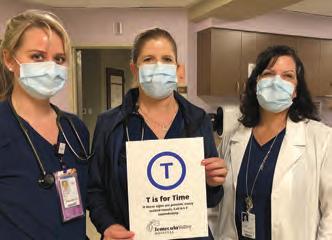
3 minute read
Understanding Stroke
Ask the person to smile. Does one side of the face droop?
Ask the person to raise both arms. Does one arm drift downward?
Advertisement

Ask the person to repeat a simple sentence. Is the speech slurred or strange?
If the person cannot perform one of these tasks, call 911 immediately.



Courtesy of Temecula Valley Hospital
According to the Centers for Disease Control and Prevention, about 800,000 Americans suffer a new or recurrent stroke every year. In fact, someone suffers a stroke every 40 seconds, and someone dies of a stroke every four minutes, making stroke the fifth leading cause of death nationwide. According to experts, a stroke should be treated with the same urgency as a heart attack. Every second is critical to patient care, survival and subsequent quality of life.
What is a stroke?
Stroke is sometimes called a brain attack. It occurs when there is an interruption in blood flow to the brain, or when a blood vessel bursts in the brain. Once deprived of the oxygen from the blood, the brain cells die. The most common form of stroke is an ischemic stroke, which is when an artery blockage occurs. Hemorrhagic strokes occur when an artery inside the brain ruptures or when an aneurysm at the base of the brain bursts. These account for about 20 percent of strokes.
Common stroke warning signs and symptoms
Suddenly experiencing the following signs and symptoms could indicate a possible stroke.
Numbness or weakness of the face, arm or leg – especially on one side of the body.
Confusion, trouble speaking or understanding.
Trouble seeing in one or both eyes.
Trouble walking, dizziness, loss of balance or coordination.
Severe headache with no known cause.
Acting FAST
Awareness is the key to stroke prevention. If you or someone you know is experiencing any of the signs or symptoms listed above, act FAST because every second counts. Remembering the word “FAST” will remind you of the following: F = FACE: Ask the person to smile. Does one side of the face droop? A = ARMS: Ask the person to raise both arms. Does one arm drift downward? S = SPEECH: Ask the person to repeat a simple sentence (i.e. “Do you know what time it is?”) Is the speech slurred or strange? T = TIME: If the person cannot perform one or more of these simple tasks, call 9-1-1 immediately.
How to reduce stroke risk
There are certain life choices that can help reduce the risk of stroke. These controllable factors include avoiding smoking and excessive alcohol consumption, eating a balanced diet and getting exercise. Other factors, such as family history, age, gender and ethnicity, cannot be controlled. Certain medical conditions can also increase the risk of stroke. These include high blood pressure, heart disease, diabetes, high cholesterol and obesity.
Rely on Temecula Valley Hospital
Temecula Valley Hospital is a designated Stroke Receiving Center for San Diego and Riverside counties. Temecula Valley Hospital’s comprehensive stroke treatment, programs and services have earned the hospital certification from DNV GL Healthcare as a Comprehensive Stroke Center, reflecting the highest level of competence for treatment of serious stroke events.
“With stroke care, you must have the best clinicians and resources, but also the ability to act quickly because of the time-critical nature of these events,” Darlene Wetton, CEO of Temecula Valley Hospital, said. “Receiving this Comprehensive Stroke Certification validates all the efforts we have put into our stroke program and ensures the health and safety of our patients, at the highest level of care our hospital can provide.”
For more information on stroke and stroke treatment at Temecula Valley Hospital, go to www.temeculavalleyhospital.com/services/ stroke-services. Physicians are independent practitioners who are not employees or agents of Temecula Valley Hospital. The hospital shall not be liable for actions or treatments provided by physicians.










